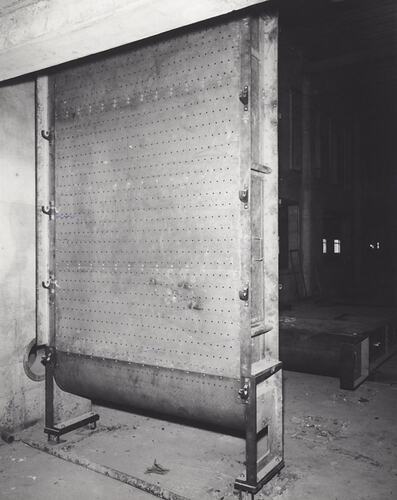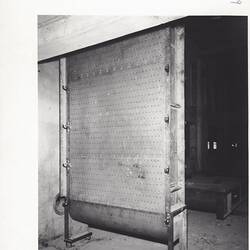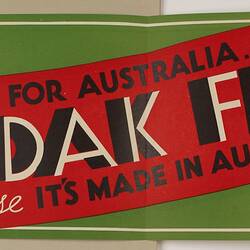Summary
Black and white silver gelatin photograph taken inside the Coating Track, Building 3, Emulsion Coating, Kodak factory, Coburg, May 1959.
This is a view of an air dryer and reverser module being installed in the Coating Track, alongside like modules in a surveyed line to form the drying section of the coating process. The Coating Track consisted of four sections. The first section was a continuous film or paper base conveyancing system, where a discrete master roll of base could be mounted on an unwinding machine and storage magazine, then spliced to the previous roll without stopping the coating process. The paper was then conveyed through the continuous coating process with correct tension and steering. Finally it went through a storage magazine and winding machine where it could be separated from the following roll and unloaded as a discrete roll. The second section was a coating station, where previously prepared emulsion taken from the emulsion store, melted to liquid consistency along with any final additional chemicals, was coated onto the film or paper base by a proprietary method. The third section, an air chiller section, where the liquid emulsion was set onto the base. The fourth section was an air dryer section, where the emulsion was dried and conditioned sufficiently to enable the base to be rolled up under tension without damaging the emulsion surface.
Since the drying process was required to be carried out over many tens of metres of base continuously, a loop transport configuration was adopted in preference to a linear one. The air dryer module depicted formed one of the loops. It consisted of a painted narrow steel framed structure with sealed ends which supported stainless steel plate sides drilled with holes to a certain pattern. A fibreglass half-round section was at the bottom and was also drilled with holes to a different pattern and sealed off from the section above. Air was introduced into one end of the top chamber at the relevant dry and wet bulb temperatures and pressure to achieve drying of the emulsion. This slightly forced the base against idle rollers on each side (the roller bearing cups are shown here), thus achieving an almost parallel separation from the plates. Air from the same source as above, but at a higher pressure, was introduced into the bottom chamber where it created an air cushion thus allowing the base to change 180 degrees direction without touching the wet emulsion. The tension of the base was controlled by torque drive rollers acting on the reverse side of the base. The base was kept aligned to the drying modules, with steering frames consisting of dual idle rollers acting on the reverse side of the base. Modules were grouped into the different stages in drying, with the dry and wet bulb temperatures of the air depending on the state of the emulsion. Generally higher drying rates were achieved at the beginning and conditioned hardening at the end, but all without physically or sensitometrically stressing the emulsion layer.
Kodak manufactured and distributed a wide range of photographic products to Australasia, such as, film, paper, chemicals, cameras and miscellaneous equipment. Its client base included amateur and professional photographers as well as specialist medical and graphic art professionals who used photography, x-ray and other imaging techniques.
This photograph is part of the Kodak collection of products, promotional materials, photographs and working life artefacts collected from Kodak Australasia in 2005 after the manufacturing plant at Coburg had closed down the year before.
Description of Content
Image of the bottom half of a steel framed structure can be seen mounted on a concrete floor with adjustable feet for alignment and perforated sides and a half round base. Cups for mounting roller bearings are located on each edge. A hole in the concrete wall aligns with the base chamber.
Physical Description
Black and white silver gelatin photograph printed on light weight paper, portrait format.
More Information
-
Collection Names
-
Collecting Areas
-
Acquisition Information
Donation from Kodak (Australasia) Pty Ltd, Ms. Kate Metcalf - Kodak (Australasia) Pty Ltd, 2005
-
Acknowledgement
Courtesy of Kodak (Australasia) Pty Ltd.
-
Place & Date Depicted
-
Organisation Depicted
Kodak (Australasia) Pty Ltd, Coburg, Greater Melbourne, Victoria, Australia, May 1959
-
Format
Photograph, Black & White
-
Inscriptions
Front, text, handwritten: 'May 1959' Back, stamp: 'KODAK ABBOTSFORD/TESTING DEPARTMENT PHOTOGRAPH/13 MAY 1959 Reference No. 59007F'
-
Classification
Manufacturing & industry, Photographic products, Factory interior views
-
Category
-
Discipline
-
Type of item
-
Image Dimensions - Photograph
253 mm (Width), 202 mm (Height)
-
Keywords
Building & Construction, Buildings, Factories, Manufacturing, Photography, Making History - Kodak Collection



